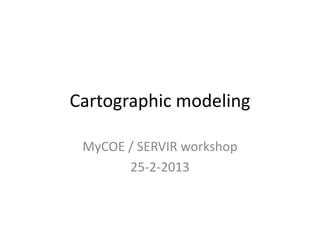Cartographic modeling presentation
- 1. Cartographic modeling MyCOE / SERVIR workshop 25-2-2013
- 8. What is a (good) map? ŌĆó Or, what should a map do? ŌĆō Communicate ŌĆō Engage ŌĆō Report ŌĆō What else?
- 9. Fundamentals ŌĆó Elements that are found on virtually all maps: ŌĆō Distance or scale ŌĆō Direction ŌĆō Legend ŌĆō [Sources of information and how processed] http://www.colorado.edu/geography/gcraft/notes/cartocom/cartocom_f.html
- 10. Fundamentals ŌĆó Elements that are sensitive to context: ŌĆō Title ŌĆō Projection ŌĆō Cartographer ŌĆō Date of production http://www.colorado.edu/geography/gcraft/notes/cartocom/cartocom_f.html
- 11. Fundamentals ŌĆó Elements that are used selectively to assist effective communication: ŌĆō Neatlines ŌĆō Locator maps ŌĆō Inset maps ŌĆō Index maps http://www.colorado.edu/geography/gcraft/notes/cartocom/cartocom_f.html
- 12. Guiding questions: ŌĆó What is the motive, intent, or goal of the map?
- 13. Guiding questions: ŌĆó Who will use it, and where will they access it? http://newswatch.nationalgeographic.com/2012/07/02/crisis-mapping-haiti/uhp2/
- 14. Guiding questions: ŌĆó Who will use it, and where will they access it? http://poleshift.ning.com
- 15. The role of projection www.coolest-gadgets.com
- 16. The role of projection http://www.treehugger.com/clean-technology/the- true-size-of-africa-continued-the-mercator- wars.html
- 17. Map communication: WhatŌĆÖs the message?
- 19. Representation I http://colorbrewer2.org/
- 20. Representation II http://colorbrewer2.org/
- 21. Representation III http://colorbrewer2.org/
- 24. Some guidelines from a trusted source ŌĆó Lettering ŌĆō All type should be from common type families (examples: Helvetica, Arial, Times New Roman, etc.). ŌĆō Type must be sufficiently large to be easily read at final print size; no type smaller than 6 point. ŌĆō Type placed on screen tints or area patterns must be clearly readable. White type can be used over dark screen tints, and area patterns can be lightened to prevent interference with type. ŌĆō The International System of Units (metric) should be used; other units may be noted in parentheses http://www.tandf.co.uk/journals/authors/raag-graphics-guidelines.pdf
- 25. Some guidelines from a trusted source ŌĆó Screen tints and patterns ŌĆō Screen tints and area pattern fills should reflect the importance of graphic elements through visual hierarchy (i.e., more important elements appear more prominently than less important elements). ŌĆō Typically, graphics should not have more than 6 tints. ŌĆō Graphic files should be submitted at 600 dpi. http://www.tandf.co.uk/journals/authors/raag-graphics-guidelines.pdf
- 26. More resources ŌĆó http://colorbrewer2.org/ ŌĆó http://cartographicperspectives.org/index.php /journal ŌĆó http://www.colorado.edu/geography/gcraft/n otes/cartocom/cartocom_f.html ŌĆó http://www.cartography2.org/ ŌĆó http://cartastrophe.wordpress.com/









![Fundamentals
ŌĆó Elements that are found on virtually all maps:
ŌĆō Distance or scale
ŌĆō Direction
ŌĆō Legend
ŌĆō [Sources of information and how processed]
http://www.colorado.edu/geography/gcraft/notes/cartocom/cartocom_f.html](https://image.slidesharecdn.com/cartographicmodelingpresentation-130320011339-phpapp02/85/Cartographic-modeling-presentation-9-320.jpg)
















